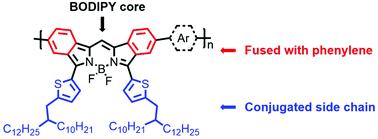BODIPY bearing alkylthienyl side chains: a new building block to design conjugated polymers with near infrared absorption for organic photovoltaics†
Abstract
To effectively harvest sunlight, polymer donors with near infrared (NIR) absorption properties are important for high-performance polymer solar cells (PSCs), especially semitransparent PSCs. However, building blocks to design this kind of polymer donor are rare. In this manuscript, we report 3,11-dibromo-5,9-bis(5-(2-decyltetradecyl)thiophen-2-yl)-7,7-difluoro-7H-6λ4,7λ4-[1,3,2]diazaborinino[4,3-a:6,1-a′]diisoindole (BOPT) as a new building block to design polymer donors with NIR absorption. In BOPT, the 4-difluoro-4-bora-3a,4a-diaza-s-indacene (BODIPY) core unit is fused with two benzene rings for a reduced bandgap and is attached with two alkylthienyl groups as conjugated side chains. We synthesized two polymers consisting of alternating BOPT units and thiophene or bithiophene units, respectively. The two polymers displayed near-infrared (NIR) light absorption with the maximum absorption peaks at wavelengths exceeding 800 nm and small bandgaps of ca. 1.3 eV. They showed high highest occupied molecular orbital (HOMO)/lowest unoccupied molecular orbital (LUMO) energy levels of about −5.0 eV/−3.5 eV and high hole mobilities of ca. 3 × 10−3 cm2 V−1 s−1. PSC devices using the two polymers as electron donors exhibited power conversion efficiencies of 2.6%. These results indicate that BOPT is a promising building block in designing polymer donors with near-infrared absorption for organic photovoltaics.



 Please wait while we load your content...
Please wait while we load your content...